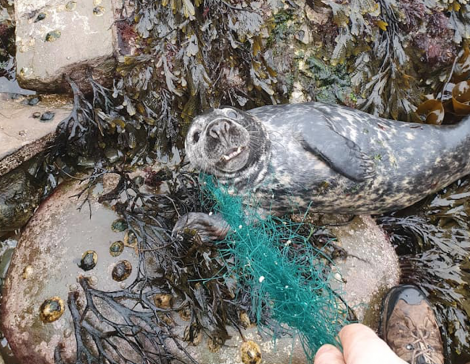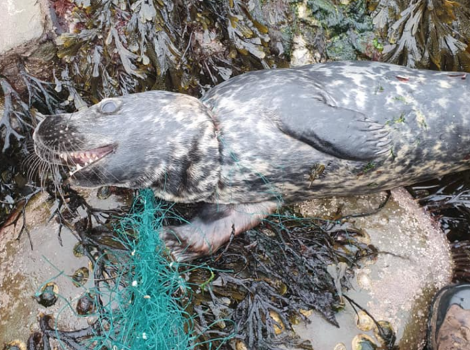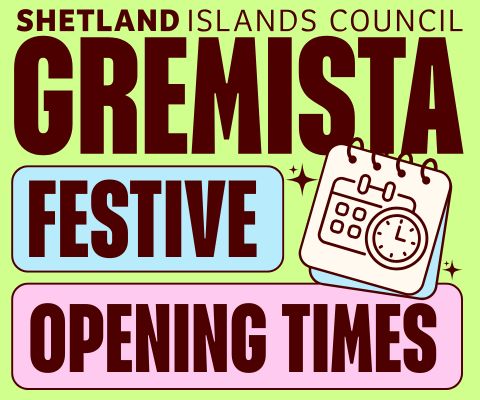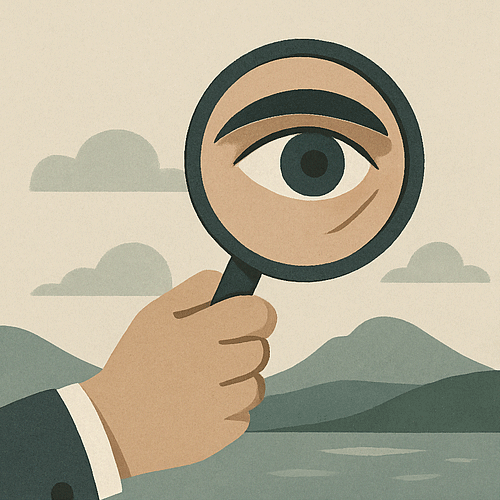Environment / Fresh reminder made over marine litter after man frees injured seal caught in netting
A LOCAL man has stressed the importance of tackling the issue of marine litter after coming to the rescue of an injured seal which had netting wrapped around its neck.
Vincent Tonner said he could immediately tell something was not right with the seal when he came across the mammal while walking on coastline in Sandwick in late March.
Upon close inspection the gill netting had cut “at least an inch or two” into the seal’s neck – but Tonner managed to cut it free and allowed the animal back into the sea.
The deep gash was not a pretty sight, but Tonner believed the netting had mostly just cut through fat.
“I could tell immediately it had something wrong with it as it saw me and wasn’t particularly fast in trying to escape like seals normally do,” he said.
“I could see it had something dragging along with it as it moved towards the sea.
“I knew if it got in the sea there was no way I would get another chance to help it so I ran and grabbed hold of the net just in time, of course it immediately turned and tried to bite me but I managed to roll it onto its back with my foot.
“I could see there was a gill net around its neck and that it had cut in very deep.”
He said the only way he could get close enough to its neck to cut the net without getting bitten was to gently hold back its head with one of my feet.
“I managed to get the net cut off and then I had to get in really close to open the wound up a little and make sure I had got all of it,” Tonner said.
Become a member of Shetland News
“It appeared to have cut through mostly fat and no further which was lucky. I then rolled it upright again.
“Seals are a lot like dogs and I have always had dogs – their body language is very similar so I could kind of read what it was trying to do and avoid being bitten.
“Once I got it upright again, I held on to it for a moment and I could feel it was still strong and agile so I knew it had a chance of recovery.”
With no phone signal to call anyone, he decided to let the seal go, with the marine animal quickly making off for the sea.
“It swam away really well and surfaced again some distance away. I sat there for a bit and it came back really close and just sat and looked at me from the water – it was pretty cool. I think in the salty water it will heal up and be okay.”
Marine pollution and litter are nothing new for Shetland’s shores, but the close encounter with the troubled seal has brought the issue back into focus.
Tonner said it is something he feels strongly about.
“I spend a lot of time wandering around banks and beaches in the more remote areas of Shetland and it’s a huge problem,” he said.
“I quite often end up dragging piles of nets back with me from my walks to dispose of them properly.
“The Voar Redd Up is a fantastic thing and there are lots of Shetlanders who clear up beaches on an ongoing basis, but it still doesn’t keep up with the sheer quantity of waste that ends up on our shores.
“If you ask the local fishermen, they will tell you some worrying figures for the amount of foreign gill nets being used around Shetland at any given time.”
In recent years Shetland News has reported on frustration among local fishermen on the amount of discarded gear they come across when operating in the waters around the isles.
They said they constantly haul up stripped back gill nets and large quantities of long lines, bundled up and allegedly thrown overboard by European fishing vessels.
Become a member of Shetland News
Shetland News is asking its readers to consider paying for membership to get additional perks:
- Removal of third-party ads;
- Bookmark posts to read later;
- Exclusive curated weekly newsletter;
- Hide membership messages;
- Comments open for discussion.
If you appreciate what we do and feel strongly about impartial local journalism, then please become a member of Shetland News by either making a single payment, or setting up a monthly, quarterly or yearly subscription.


































































